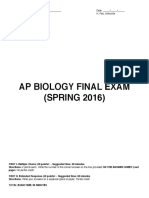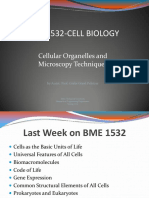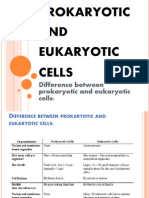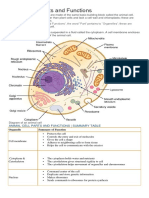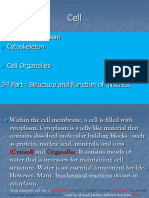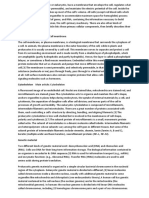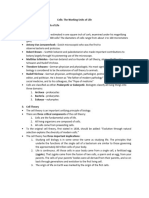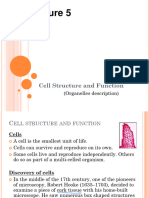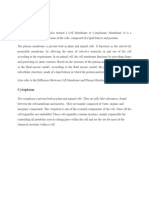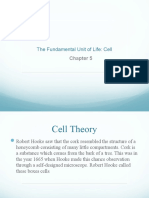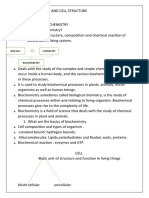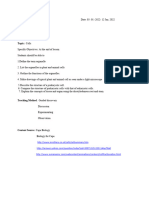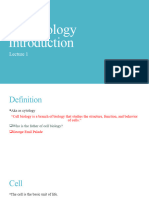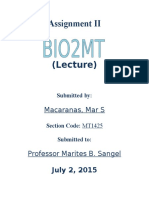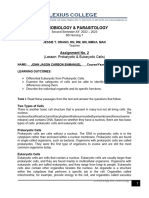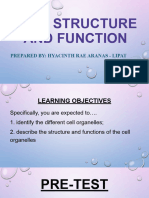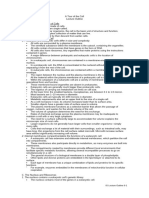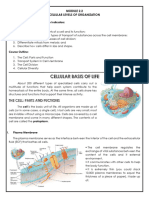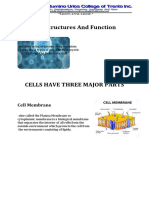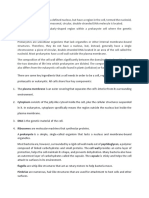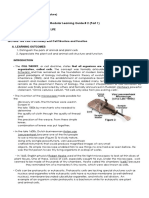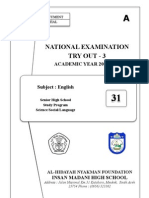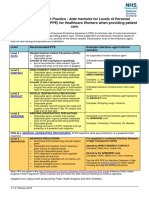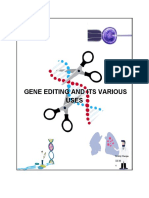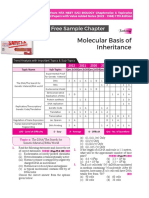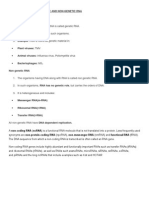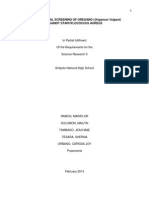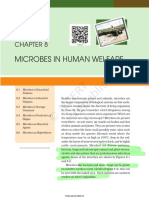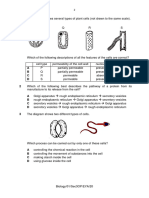Phospholipids (Fats With Phosphorous Attached), Which at Body Temperature Are
Phospholipids (Fats With Phosphorous Attached), Which at Body Temperature Are
Uploaded by
Cmae VidadCopyright:
Available Formats
Phospholipids (Fats With Phosphorous Attached), Which at Body Temperature Are
Phospholipids (Fats With Phosphorous Attached), Which at Body Temperature Are
Uploaded by
Cmae VidadOriginal Description:
Original Title
Copyright
Available Formats
Share this document
Did you find this document useful?
Is this content inappropriate?
Copyright:
Available Formats
Phospholipids (Fats With Phosphorous Attached), Which at Body Temperature Are
Phospholipids (Fats With Phosphorous Attached), Which at Body Temperature Are
Uploaded by
Cmae VidadCopyright:
Available Formats
Mosaic properties of cell membranes
The fluid-mosaic model describes the plasma membrane of animal cells. The plasma membrane that surrounds these cells has two layers (a bilayer) of phospholipids (fats with phosphorous attached), which at body temperature are like vegetable oil (fluid). And the structure of the plasma membrane supports the old saying, Oil and water dont mix.
Microtubules are conveyer belts inside the cells. They move vesicles, granules, organelles like mitochondria, and chromosomes via special attachment proteins. They also serve a cytoskeletal role. Structurally, they are linear polymers of tubulin which is a globular protein. These linear polymers are called protofilaments. The figure to the left shows a three dimensional view of a microtubule.
INTERMIDIATE FILAMENTS
Intermediate filaments (IFs) are a family of related proteins that share common structural and sequence features. Intermediate filaments have an average diameter of 10 nanometers, which is between that of actin (microfilaments) and microtubules, although they were initially designated 'intermediate' because their average diameter is between those of narrower microfilaments (actin) and wider myosin filaments.[1] Most types of intermediate filaments are cytoplasmic, but one type, the lamins, are nuclear.
Endoplasmic Reticulum
The
endoplasmic reticulum (ER) is repsonible for the production of the protein and lipid components of most of the cell's organelles. The ER contains a great amount of folds - but the membrane forms a single sheet enclosing a single closed sac. This internal space is called the ER lumen. The ER is additionally responsible for moving proteins and other carbohydrates to the Golgi apparatus, to the plasma membrane, to the lysosomes, or wherever else needed.
There are two types of ER - rough, which is coated with ribosomes, and smooth, which isn't. Rough ER is the site of protein synthesis. The smooth ER is where the vesicles carrying newly synthesized proteins (from the rough ER) are budded off
(1) A minute particle composed of protein and ribonucleic acid (RNA) that serves as the site of protein synthesis. (2) A molecule consisting of two subunits that fit together and work as one to build proteins according to the genetic sequence held within the messenger RNA (mRNA). Using the mRNA as a template, the ribosome traverses each codon, pairing it with the appropriate amino acid. This is done through interacting with transfer RNA (tRNA) containing a complementary anticodon on one end and the appropriate amino acid on the other. (3) A sphere-shaped structure found in the cytoplasm of prokaryotic and eukaryotic cells. Some ribosomes occur freely in the cytosol whereas others are attached to the nuclear membrane or to the endoplasmic reticulum (ER) giving the latter a rough appearance, hence, the name rough ER or rER.
MITOCHONDRIA
Mitochondria are the energy factories of the cells. The energy currency for the work that animals must do is the energy-rich molecule adenosine triphosphate (ATP). The ATP is produced in the mitochondria using energy stored in food. Just as the chloroplasts in plants act as sugar factories for the supply of ordered molecules to the plant, the mitochondria in animals and plants act to produce the ordered ATP molecules as the energy supply for the processes of life.
LYSOSOMES
Lysosomes are the cell's waste disposal system and can digest many compounds. They are used for the digestion of macromolecules from phagocytosis (ingestion of other dying cells or larger extracellular material, like foreign invading microbes), endocytosis (where receptor proteins are recycled from the cell surface), and autophagy (where in old or unneeded organelles or proteins, or microbes that have invaded the cytoplasm are delivered to the lysosome). Autophagy may also lead to
autophagic cell death, a form of programmed self-destruction, or autolysis, of the cell, which means that the cell is digesting itself.
It processes and packages macromolecules, such as proteins and lipids, after their synthesis and before they make their way to their destination; it is particularly important in the processing of proteins for secretion. The Golgi apparatus forms a part of the cellular endomembrane system.
VACUOLE
A vacuole is a membrane-bound organelle which is present in all plant and fungal cells and some protist, animal[1] and bacterial cells.[2] Vacuoles are essentially
enclosed compartments which are filled with water containing inorganic and organic molecules including enzymes in solution, though in certain cases they may contain solids which have been engulfed. Vacuoles are formed by the fusion of multiple membrane vesicles and are effectively just larger forms of these.[3] The organelle has no basic shape or size; its structure varies according to the needs of the cell.
CENTRIOLE
A centriole is a barrel-shaped cell structure[1] found in most animal eukaryotic cells, though it is absent in higher plants and most fungi.[2] The walls of each centriole are usually composed of nine triplets of microtubules (protein of the cytoskeleton).
NUCLEAR ENVELOPE
You might also like
- Animal Cell Parts and Functions - Summary TableDocument16 pagesAnimal Cell Parts and Functions - Summary TableAnnie Lyn Villamor100% (1)
- Animal Cell Parts and FunctionsDocument8 pagesAnimal Cell Parts and FunctionsKarren Ferrer-Mora Handayan100% (2)
- AP Biology Final Spring 2016Document6 pagesAP Biology Final Spring 2016Rohan SharmaNo ratings yet
- Lec-8,9 CellsDocument30 pagesLec-8,9 CellsAbdullah-Al-mehedi HiraNo ratings yet
- Marquez 3d CellDocument5 pagesMarquez 3d CellSatori TendōNo ratings yet
- Cells, Organelles, Microscopy TechniquesDocument34 pagesCells, Organelles, Microscopy TechniquesJeffrey100% (1)
- Prokaryotic and Eukaryotic CellsDocument18 pagesProkaryotic and Eukaryotic Cellssalahuddin_md5935100% (1)
- Morphological Function of The Cell Presentation PHDocument52 pagesMorphological Function of The Cell Presentation PHDoc HamsNo ratings yet
- Ans 201 Anatomy and Physiology of Farm AnimalsDocument33 pagesAns 201 Anatomy and Physiology of Farm AnimalsAdewaleNo ratings yet
- Forest Botany For Forestry StudentsDocument39 pagesForest Botany For Forestry StudentsMadan ThapaNo ratings yet
- JetDocument14 pagesJetAnnie Lyn VillamorNo ratings yet
- Lecture 2 CytoplasmmDocument46 pagesLecture 2 Cytoplasmmdiyarberwari15No ratings yet
- Membrane Main Article: Cell MembraneDocument3 pagesMembrane Main Article: Cell MembraneAriella ZoeyNo ratings yet
- Class 11 Biology Chapter 8 - Revision NotesDocument10 pagesClass 11 Biology Chapter 8 - Revision NotesHARKIRIT KAUR100% (1)
- Cell Organelles - Notes Cell Theory Cells Are The Basic Unit of Life. The Cell Theory States ThatDocument7 pagesCell Organelles - Notes Cell Theory Cells Are The Basic Unit of Life. The Cell Theory States ThatSpongie BobNo ratings yet
- Animal Cell DefinitionDocument10 pagesAnimal Cell DefinitionAngelique VeteNo ratings yet
- Chapte 3Document22 pagesChapte 3axmedjiinjeaxmedNo ratings yet
- Cell Structures and Its Functions Cell WallDocument5 pagesCell Structures and Its Functions Cell WallNorjanah H. M. AmbolaNo ratings yet
- g11 Els OrganellesDocument3 pagesg11 Els OrganellesJarod PeñaflorNo ratings yet
- Biology REVIEW FOR CMDocument12 pagesBiology REVIEW FOR CMyangyang804574No ratings yet
- Bio 103 L5 NIADocument31 pagesBio 103 L5 NIAsubrotoghosh2001No ratings yet
- Cells InfoDocument4 pagesCells InfoLyza PacibeNo ratings yet
- Document 4Document11 pagesDocument 4pragany.saiNo ratings yet
- Fundamentals of Crop PhysiologyDocument19 pagesFundamentals of Crop PhysiologyRsNo ratings yet
- Gen BioCell TheoryDocument18 pagesGen BioCell TheoryBernadeth CayaosNo ratings yet
- Week 7. Reading Materials - Cell Structure and Function 2021Document4 pagesWeek 7. Reading Materials - Cell Structure and Function 2021yui kirigayayuukiNo ratings yet
- Chapter - 5 Cell - The Fundamental Unit of Life - Class Ix Cbse - ScienceDocument34 pagesChapter - 5 Cell - The Fundamental Unit of Life - Class Ix Cbse - ScienceMadhav DayareNo ratings yet
- Cell BiologyDocument4 pagesCell BiologyasadzamanchathaNo ratings yet
- LESSONS in BIOCHEMDocument39 pagesLESSONS in BIOCHEMMikhael Jay IglesiasNo ratings yet
- Cells: Cytoplasm (Or Cytosol) - This Is The Solution Within The Cell Membrane. It Contains Enzymes ForDocument12 pagesCells: Cytoplasm (Or Cytosol) - This Is The Solution Within The Cell Membrane. It Contains Enzymes ForAlix AliNo ratings yet
- Grade 12 Prokyrotic and Eukyarotic CellDocument8 pagesGrade 12 Prokyrotic and Eukyarotic CellOlayinka SalmonNo ratings yet
- CytologyDocument15 pagesCytologyaviatorlegacy01No ratings yet
- Cell Biology Lecture 1Document17 pagesCell Biology Lecture 1NIMRAHNo ratings yet
- Human Cell, Feb. 2012.Document3 pagesHuman Cell, Feb. 2012.Nina UrakovićNo ratings yet
- Cell 2 Grading in Science ViiDocument6 pagesCell 2 Grading in Science ViiJerez De PaduaNo ratings yet
- BiochemistryDocument531 pagesBiochemistrySiss Thwae100% (1)
- Cellular Ultrastructure: Eukaryotic CellsDocument9 pagesCellular Ultrastructure: Eukaryotic CellsPiriyatharshini RamanathNo ratings yet
- Trixie OrganellesDocument2 pagesTrixie OrganellesMir SantillanNo ratings yet
- Animal Physiology Theory Lec1Document24 pagesAnimal Physiology Theory Lec1ao868598No ratings yet
- Cytoplasm 2.: Cell OrganellesDocument6 pagesCytoplasm 2.: Cell OrganellesSai Deekshita VijayakumarNo ratings yet
- Assignment II: Macaranas, Mar SDocument7 pagesAssignment II: Macaranas, Mar SMar MacaranasNo ratings yet
- ENMANUEL MC 3 BSN1 Assignment No. 2 Prokaryotic Eukaryotic First TrinalDocument6 pagesENMANUEL MC 3 BSN1 Assignment No. 2 Prokaryotic Eukaryotic First TrinalJason Carbon EnmanuelNo ratings yet
- CellDocument11 pagesCellNicole ArangurenNo ratings yet
- CropDocument11 pagesCropHall OwnNo ratings yet
- Only Eukaryotic Cells Have A Nucleus. in Prokaryotic Cells, DNA Is Found in The CytoplasmDocument14 pagesOnly Eukaryotic Cells Have A Nucleus. in Prokaryotic Cells, DNA Is Found in The Cytoplasmrakan ilyasNo ratings yet
- The Basic of LifeDocument21 pagesThe Basic of LifeJALAL JAMINo ratings yet
- Cell Structure and FunctionDocument38 pagesCell Structure and FunctionHyacinth RaeNo ratings yet
- The Cell Theory of BiologyDocument10 pagesThe Cell Theory of BiologyFrezelVillaBasiloniaNo ratings yet
- 06 - A Tour of The Cell - LODocument7 pages06 - A Tour of The Cell - LOAngelineNo ratings yet
- Cell Organelles 2Document10 pagesCell Organelles 2Hardik tyagiNo ratings yet
- Life Processes and Cells: Chapter 1:-Longman GCSE BiologyDocument16 pagesLife Processes and Cells: Chapter 1:-Longman GCSE BiologynkllaeNo ratings yet
- CellDocument4 pagesCellPrincess MillanNo ratings yet
- Cell Structure Function and PropertiesDocument10 pagesCell Structure Function and PropertiesWanda JohnNo ratings yet
- MODULE 2.2 Cellular Level of OrganizationDocument11 pagesMODULE 2.2 Cellular Level of OrganizationKate Andrea PanizalesNo ratings yet
- Biology Class 9 Chapter 5Document4 pagesBiology Class 9 Chapter 5himanshusingh8804No ratings yet
- Immunology: Section 4-2, Parts of The Eukaryotic CellDocument20 pagesImmunology: Section 4-2, Parts of The Eukaryotic CellJoia De LeonNo ratings yet
- Cell Structures and Function: CellsDocument8 pagesCell Structures and Function: CellsChardean Gel BaclaanNo ratings yet
- Nucleoid: The Irregularly-Shaped Region Within A Prokaryote Cell Where The GeneticDocument5 pagesNucleoid: The Irregularly-Shaped Region Within A Prokaryote Cell Where The GeneticHustler ZaydeNo ratings yet
- MLG 2 (Part 1) The Cell Theory and Cell Structure and FunctionsDocument5 pagesMLG 2 (Part 1) The Cell Theory and Cell Structure and FunctionsJohn Tolentino LaronaNo ratings yet
- Eukaryotic CellsDocument21 pagesEukaryotic Cellsjaysenires13tkdNo ratings yet
- The Basics of Cell Life with Max Axiom, Super Scientist: 4D An Augmented Reading Science ExperienceFrom EverandThe Basics of Cell Life with Max Axiom, Super Scientist: 4D An Augmented Reading Science ExperienceNo ratings yet
- RNA and Protein SynthesisDocument51 pagesRNA and Protein SynthesisCanonizado ShenaNo ratings yet
- Try Out 3 (Paper A)Document13 pagesTry Out 3 (Paper A)Moh. MashadiNo ratings yet
- Appendix 16 - Best Practice - Aide Memoire For Levels of Personal Protective Equipment (PPE) For Healthcare Workers When Providing Patient CareDocument1 pageAppendix 16 - Best Practice - Aide Memoire For Levels of Personal Protective Equipment (PPE) For Healthcare Workers When Providing Patient CareBemnet TesfayeNo ratings yet
- Neonatal InfectionsDocument18 pagesNeonatal InfectionsSanthosh.S.U100% (1)
- Hematology: Monoclonal Gammapathies-Multiple Myeloma Lymphoma Hodgkin and Non HodgjknDocument29 pagesHematology: Monoclonal Gammapathies-Multiple Myeloma Lymphoma Hodgkin and Non HodgjknBelu DanielaNo ratings yet
- 0610 BIOLOGY: MARK SCHEME For The October/November 2014 SeriesDocument12 pages0610 BIOLOGY: MARK SCHEME For The October/November 2014 SeriessrividhyaNo ratings yet
- Bio ProjectDocument11 pagesBio ProjectKshitij SharmaNo ratings yet
- Renal Function Based Dose Adjustments Adult Inpatient - Ambulatory 17.06.27Document89 pagesRenal Function Based Dose Adjustments Adult Inpatient - Ambulatory 17.06.27benny christantoNo ratings yet
- Crosstalk Among Plant Growth Regulators and Signaling MoleculesDocument3 pagesCrosstalk Among Plant Growth Regulators and Signaling MoleculesasifNo ratings yet
- Rhabdoviridae: Viruses With Sean Elliott, MDDocument7 pagesRhabdoviridae: Viruses With Sean Elliott, MDMuh Ikhlasul AmalNo ratings yet
- Molecular Basis of Inheritance: Free Sample ChapterDocument33 pagesMolecular Basis of Inheritance: Free Sample ChapterJiya ShahNo ratings yet
- Sigatoka Leaf SpotDocument13 pagesSigatoka Leaf SpotRakesh KumarNo ratings yet
- Lymphoproliferative DisordersDocument29 pagesLymphoproliferative DisordersShaza ElkourashyNo ratings yet
- Laboratory Diagnosis of Mycobacterium Tuberculosis Infection and Disease in ChildrenDocument8 pagesLaboratory Diagnosis of Mycobacterium Tuberculosis Infection and Disease in ChildrenFaradilla FirdausaNo ratings yet
- Applications of Humic and Fulvic Acids in AquacultureDocument2 pagesApplications of Humic and Fulvic Acids in AquacultureAlexandra Nathaly Beltran Contreras100% (1)
- Difference Between Genetic and Non Genetic RnaDocument1 pageDifference Between Genetic and Non Genetic RnaMatin Ahmad KhanNo ratings yet
- Acute Myeloid Leukemia in Children and Adolescents - UpToDateDocument33 pagesAcute Myeloid Leukemia in Children and Adolescents - UpToDateainihanifiah100% (1)
- Phytochemical Screening of Oregano Against Staphylococcus AureusDocument22 pagesPhytochemical Screening of Oregano Against Staphylococcus AureusSherna TesaraNo ratings yet
- Usefulness of Elevated Troponin To Predict Death in Patients With COVID-19 and Myocardial InjuryDocument7 pagesUsefulness of Elevated Troponin To Predict Death in Patients With COVID-19 and Myocardial InjurySilvhy yujraNo ratings yet
- A 9 Year Old Girl Presents With Body Swelling Shortness of Breath and BackacheDocument9 pagesA 9 Year Old Girl Presents With Body Swelling Shortness of Breath and Backachefurr singhNo ratings yet
- 2 Lecture 2019-09-26 07 - 48 - 00Document75 pages2 Lecture 2019-09-26 07 - 48 - 00gothai sivapragasamNo ratings yet
- Serologi Elisa: Engla MerizkaDocument43 pagesSerologi Elisa: Engla MerizkaHijazh PratamaNo ratings yet
- Diagnosis and Treatment of Mast Cell DisordersDocument11 pagesDiagnosis and Treatment of Mast Cell DisordersLaura Colorado DuarteNo ratings yet
- Liver Case StudyDocument6 pagesLiver Case StudyGhulam MustafaNo ratings yet
- Microbes Ncert Highlight by Seep PahujaDocument12 pagesMicrobes Ncert Highlight by Seep Pahujaamar jadhavNo ratings yet
- Sec 3 OP - EOY 2020 P1Document18 pagesSec 3 OP - EOY 2020 P1otakukat763No ratings yet
- Biological ClasifficationDocument6 pagesBiological Clasifficationchannel of dhyanaNo ratings yet
- Biology Paper 1 SLDocument12 pagesBiology Paper 1 SLesteban1013264503No ratings yet
- Inserto H Pylori Antigeno InglesDocument2 pagesInserto H Pylori Antigeno Inglessolucionesdiagnosticas502No ratings yet


